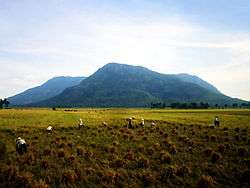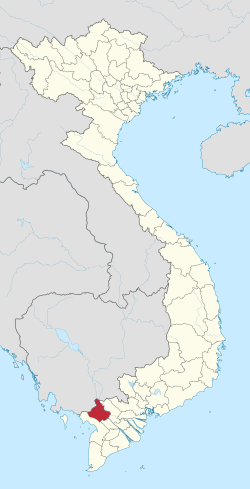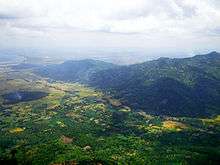An Giang Province
| An Giang Province Tỉnh An Giang | |
|---|---|
| Province | |
 Harvest in Tinh Bien, An Giang | |
 Location of An Giang within Vietnam | |
| Coordinates: 10°30′N 105°10′E / 10.500°N 105.167°ECoordinates: 10°30′N 105°10′E / 10.500°N 105.167°E | |
| Country |
|
| Region | Mekong Delta |
| Capital of Province | Long Xuyên City |
| Government | |
| • People's Council Chair | Võ Thanh Khiết |
| • People's Committee Chair | Nguyễn Hoàng Việt |
| Area | |
| • Total | 3,406.2 km2 (1,315.1 sq mi) |
| Population (2004) | |
| • Total | 2,170,100 |
| • Density | 640/km2 (1,700/sq mi) |
| Demographics | |
| • Ethnicities | Vietnamese, others |
| Time zone | UTC+7 (ICT) |
| Area codes | 296 |
| ISO 3166 code | VN-44 |
| Website |
www |
An Giang (Vietnamese: [ʔaːŋ jaːŋ] (![]()
Geography
An Giang occupies a position in the upper reaches of the Mekong Delta. The Hậu Giang and Tiền Giang branches of the Mekong River are the dominant geographical features of the province. With the exception of the west, most of An Giang is fairly flat, and is criss-crossed by many canals and small rivers. This terrain has led to An Giang being a significant agricultural center, producing significant quantities of rice. The Cam Mountains, also known as the Thất Sơn range or the "Seven Mountains", are located in the western Tịnh Biên District. Followers of the Bửu Sơn Kỳ Hương tradition, founded in An Giang in 1849, refer to these mountains as Bửu Sơn, "Precious Mountains".
Administrative divisions
An Giang is subdivided into 11 district-level sub-divisions:
- Districts:
- An Phú: 2 towns and 12 rural communes
- Châu Phú: 1 town and 12 rural communes
- Châu Thành: 1 town and 12 rural communes
- Chợ Mới: 2 towns and 16 rural communes
- Phú Tân: 2 towns and 16 rural communes
- Thoại Sơn: 3 towns and 14 rural communes
- Tịnh Biên: 3 towns and 11 rural communes
- Tri Tôn: 2 towns and 13 rural communes
- District-level town:
- Tân Châu: 5 wards and 9 rural communes
- Provincial cities:
- Châu Đốc: 5 wards and 2 rural communes
- Long Xuyên: 11 wards and 2 rural communes (capital of province)
- They are further subdivided into 16 commune-level towns (or townlets), 119 communes, and 21 wards (156 in total).
Vehicle registration plate
- Long Xuyên 67-B1-B2 XXX.XX
- Châu Đốc 67-E1 XXX.XX
- Tân Châu 67-H1 XXX.XX
- Châu Phú 67-D1 XXX.XX
- Phú Tân 67-K1 XXX.XX
- An Phú 67-G1 XXX.XX
- Châu Thành 67-C1 XXX.XX
- Chợ Mới 67-L1-L2 XXX.XX
- Thoại Sơn 67-M1 XXX.XX
- Tri Tôn 67-N1 XXX.XX
Demographics
An Giang first became a province in 1832, having been settled by ethnically Vietnamese migrants moving southwards in search of new land. It is believed that An Giang was once an important center of the vanished Óc Eo culture, presumably owing to its position on the river. Traditionally, An Giang has been known for its silk industry.
An Giang is home to a sizable number of people from Vietnam's ethnic minorities. Due to the province's proximity to Cambodia, the Khmer Krom are the largest non-Vietnamese group. Other groups, such as the Chams and ethnic Chinese (Hoa), are also found in An Giang.
Etymology
The province's name is derived from the Sino-Vietnamese word: 安江, meaning "peaceful river".[1]
Notable people from An Giang
Politics
- Tôn Đức Thắng, prominent Communist and former President of the Democratic Republic of Vietnam; later became the first President of the Socialist Republic of Vietnam (Long Xuyên).
- Nguyễn Ngọc Thơ, vice-president of the Republic of Vietnam before April 30, 1975 (Long Xuyên).
- Nguyễn Văn Hưởng, former minister of Vietnamese health (Chợ Mới).
- Chau Sen Cocsal Chhum, Khmer Krom and Prime Minister of Cambodia in 1962
Literature and arts
- Nguyễn Quang Sáng, writer (Chợ Mới).
- Anh Đức, writer (Châu Thành).
- Nguyễn Chánh Sắt, writer (Tân Châu).
- Vương Trung Hiếu, writer (Thoại Sơn).
- Trịnh Bửu Hoài, writer (Châu Đốc).
- Viễn Phương, poet (Tân Châu).
- Hoàng Hiệp, musician (Chợ Mới).
- Song Ngọc, musician (Long Xuyên).
- Chóe, painter (Chợ Mới).
- Bạch Tuyết, artist (An Phú).
- Tạ Minh Tâm, artist (Long Xuyên).
- Đức Tuấn, singer (Long Xuyên).
- Đông Đào, singer (Phú Tân).
Education
- Võ Tòng Xuân, academic, agronomist and former rector of An Giang University (Tri Tôn).
- Trần Hữu Thường, teacher (Tân Châu).
- Lê Minh Tùng, Vice-Chairman of An Giang province and current rector of An Giang University.
Religions
- Huỳnh Phú Sổ, founder of the Hòa Hảo sect of Buddhism (Phú Tân).
Military
- Trần Văn Thành, leader of the revolt against the French (1867-1873).
- Thư Ngọc Hầu, general of Nguyễn Dynasty (Chợ Mới).
- Trần Bá Lộc, collaborator with France (Chợ Mới).
Other
- Đoàn Minh Huyên, founder of the Bửu Sơn Kỳ Hương tradition
- Vũ Cát Tường, the singer of Vietnam
See also
- Basa fish
- Tức Dụp
References
- ↑ Đại Nam Nhất Thống Chí - Lục Tỉnh Nam Kỳ (Unification Records of Dai Nam - Six Provinces of Cochinchina). Hạ. Nha Văn hóa (Bureau of Culture of South Vietnam). 1959. p. 37.
External links
| Wikimedia Commons has media related to An Giang Province. |

